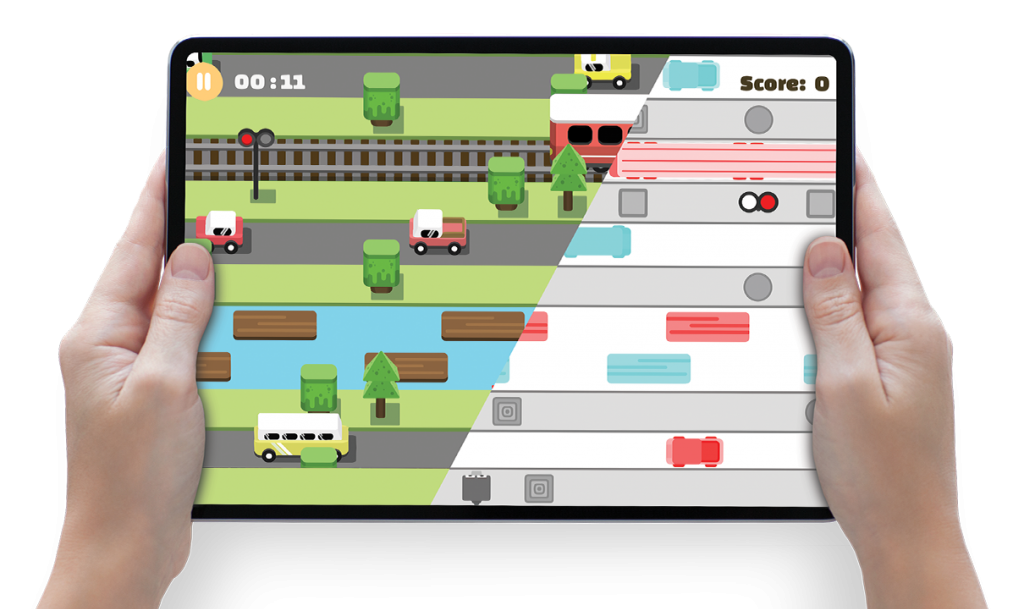Colorimetry

Normal vision involves more than just good eyesight. Some people find that although they can see perfectly clearly, there are specific patterns that cause visual disturbance and discomfort.1 The solution is tinted lenses – colour filters that reduce perceptual discomfort and provide relief from symptoms.2 Our Adelaide practice is equipped with a colorimeter that can assess what tint is best suited to reduce your symptoms. If you suspect you would benefit from tinted lenses, book an appointment or contact us today.
‘Pattern glare’ is a collection of symptoms which often result in visual stress (Meares-Irlen Syndrome).3 It can become noticeable during tasks which involve looking at repetitive intermittent black and white lines - the most common of which is reading.
What causes pattern glare?
Pattern glare is caused when repetitive striped patterns overexcite the visual cortex of the brain. It can be tested for using the Pattern Glare Test, which involves presenting the patient with three different patterns on a piece of card. Of these three patterns, the first has spatial frequency that is too low to produce symptoms, and the last has aspatial frequency that is too high. The second pattern has a spatial frequency of 2-5 cycles per degree, which can generate symptoms in a person with pattern glare.

What are the symptoms of pattern glare?
The most obvious symptoms of pattern glare are eye strain, headaches, and light sensitivity.4 Pattern glare is particularly obvious when reading. Some symptoms that may arise during this activity include:
Letters appearing to move (this can take many forms including up and down, side to side, words merging, breaking up and moving at the beginning and end of lines)
- Letters appearing to blue especially with closely spaced fine print
- Letters appearing double
- Letters changing size
- Letters changing contrast
- Letters or words reversing
- Colours or shapes appearing on the page
- Flickering and flashes on light on the page
How does colorimetry help pattern glare?
When projected on a white page with black text, certain wavelengths of light help to reduce symptoms provoked by pattern glare. The retinal image processed by the brain is more easily interpreted when there is a change in colour composition of the background on which the text is overlaid. The exact colour that best achieves this effect changes from person to person, which is why it’s important for patients with pattern glare to undergo colorimetry assessment. Once this optimal colour has been discovered, lenses for spectacles can be made with this tint to reduce eye strain and visual discomfort.5,6
Pattern glare often occurs without associated health conditions, although it can arise with concussion, epilepsy and dyslexia.7,8,9 It is important to see an optometrist if you believe you experience pattern glare, both as a step towards management of symptoms and also to affirm your overall well-being.

References
1) Wilkins, A.J. and Nimmo-Smith, M.I. (1984).On the reduction of eye-strain when reading. Ophthalmic and Physiological Optics, 4, 53-59.
2) Allen, P.M, Hussain, A, Usherwood, C,Wilkins, A.J. (2010). Pattern-related visual stress, chromaticity and accommodation. Investigative Ophthalmology and Vision Science, in press
3) Hollis, J. and Allen, P.M. (2006).Screening for Meares-Irlen sensitivity in adults: can assessment methods predict changes in reading speed? Ophthalmic and Physiological Optics, 26,566-571.
4) Wilkins, A.J., Nimmo-Smith, M.I., Tait, A.,McManus, C., Della Sala, S., Tilley, A., Arnold, K., Barrie, M., Scott, S.(1984). A neurological basis for visual discomfort. Brain, 107, 989-1017
5) Evans, B.J.W., Stevenson, S.J. (2008). The Pattern Glare Test: a review and determination of normative values. Ophthalmic and Physiological Optics, 28, 295-309.
6) Allen, P.M. Gilchrist, J.M. and Hollis, J.(2008). Use of visual search in the assessment of pattern related visual stress(PRVS) and its alleviation by coloured filters. Investigative Ophthalmology and Vision Science, 49(9), 4210-4218.
7) Kriss I, Evans BJW. The relationship between dyslexia and Meares-Irlen syndrome. J Res Read 2005;28:350-364
8) Wilkins AJ, Baker A, Amin D, Smith S,Bradford J, Zaiwalla Z, Besag FMC, Binnie CD, Fish D. Treatment of photosensitive epilepsy using coloured glasses. Seizure1999;8:444-449
9) Tosta S, Johnosn P. Traumatic brain injury and irlen syndrome. J Head Trauma Rehabil 2009;24:395
FAQs
Please browse through some of our most frequently asked questions on this topic.
Speak to our friendly team today
Book your appointment now for personalised eye care tailored just for you.











